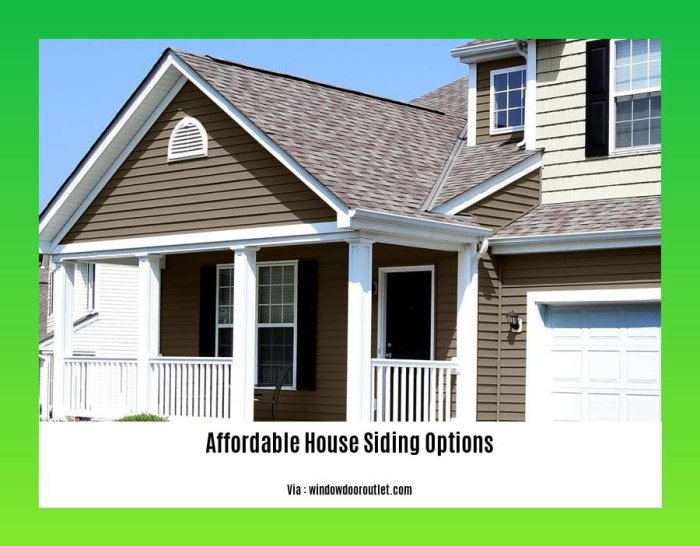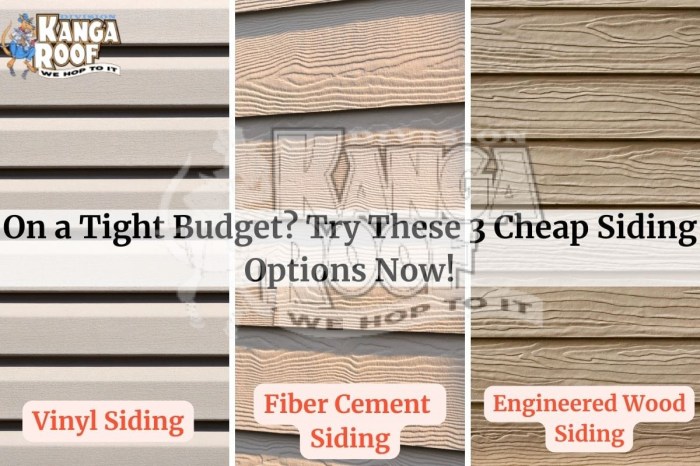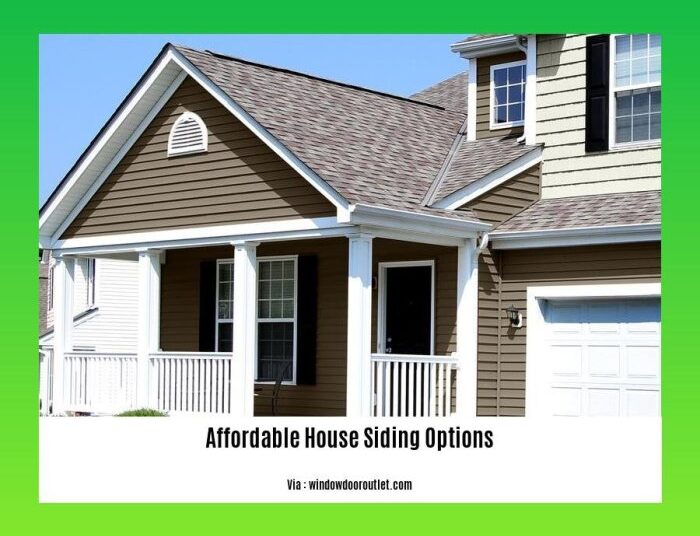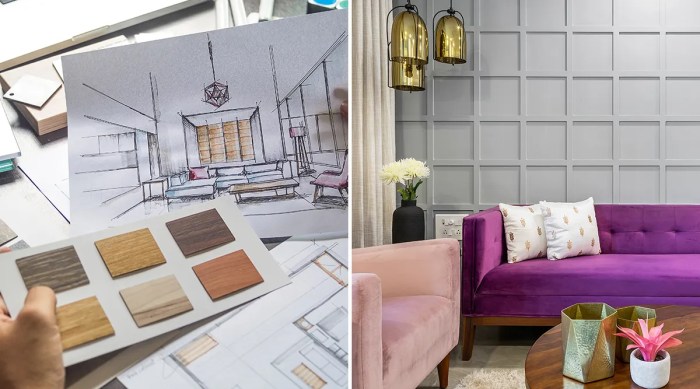As affordable home siding options take the spotlight, this introduction invites readers into a realm of expertise, ensuring an informative journey that is both engaging and refreshingly unique.
The subsequent paragraph will delve into the specifics of the topic, providing a detailed overview.
Types of Affordable Home Siding
When it comes to affordable home siding options, there are several choices available to homeowners. Each type of siding comes with its pros and cons, as well as varying levels of durability. Here are some common types of affordable home siding:
Vinyl Siding
- Pros: Cost-effective, easy to maintain, comes in a variety of colors and styles.
- Cons: Can crack or fade over time, may not be as durable as other options.
Fiber Cement Siding
- Pros: Resistant to fire, insects, and rot, durable, low maintenance.
- Cons: Higher initial cost compared to vinyl, may require professional installation.
Wood Siding
- Pros: Natural look, environmentally friendly, can be painted or stained.
- Cons: Prone to rot, insects, and moisture damage, higher maintenance required.
Engineered Wood Siding
- Pros: Less expensive than natural wood, more durable, easy to install.
- Cons: Can still be susceptible to moisture damage like natural wood.
Materials for Affordable Siding

When it comes to affordable home siding options, choosing the right material is crucial. Different materials offer varying cost-effectiveness and maintenance requirements.
Vinyl Siding
Vinyl siding is a popular choice for homeowners looking for affordability. It is cost-effective both in terms of initial installation and long-term maintenance. Vinyl siding is durable, resistant to rot and insects, and comes in a variety of colors and styles.
However, it may not be as environmentally friendly as other options.
Wood Siding
Wood siding can provide a classic and natural look to your home. While initial costs for wood siding can be higher than vinyl, it is still considered affordable in the long run. However, wood siding requires more maintenance, such as regular painting or staining to protect it from moisture and pests.
Fiber Cement Siding
Fiber cement siding is a versatile and durable option that can mimic the look of wood or stucco at a lower cost. It is known for its resistance to fire, insects, and rot. While the initial cost of fiber cement siding may be higher than vinyl, it requires minimal maintenance over time, making it a cost-effective choice.
Metal Siding
Metal siding, such as aluminum or steel, is another affordable option for homeowners. It is durable, low-maintenance, and can withstand harsh weather conditions. Metal siding can be cost-effective in the long term due to its longevity and minimal upkeep requirements.
Installation Considerations
When it comes to installing affordable home siding, there are several key factors to consider to ensure a successful and long-lasting installation. Proper insulation, the right tools and equipment, and attention to detail are all essential components of a successful siding installation.
Importance of Proper Insulation
Proper insulation is crucial when installing siding on your home. Insulation helps regulate the temperature inside your home, keeping it cooler in the summer and warmer in the winter. It also helps reduce energy costs by improving the overall energy efficiency of your home.
Without proper insulation, your siding may not perform as effectively and could lead to issues such as moisture problems, mold growth, and increased energy bills.
Tools and Equipment Needed for DIY Siding Installation
If you're planning to tackle a DIY siding installation, make sure you have the right tools and equipment on hand. Some essential tools for siding installation include a hammer, tape measure, chalk line, utility knife, circular saw, and a level.
You may also need a nail gun, ladder, safety glasses, and gloves for safety purposes. Additionally, having the proper materials such as siding panels, trim pieces, fasteners, and caulking is essential for a successful installation.
Design Options and Aesthetics
When it comes to affordable home siding, design options and aesthetics play a crucial role in enhancing the overall look of a house. Choosing the right siding can not only improve curb appeal but also add value to your property.
Color and Texture
When selecting siding for your home, consider the color and texture carefully. The color of the siding should complement the architectural style of your house and blend well with the surroundings. Neutral tones like beige, gray, or white are versatile options that can work with various design styles.
On the other hand, bolder colors can make a statement and add personality to your home.Textures also play a significant role in the aesthetics of your home. Different siding materials offer various textures, from smooth finishes to wood-grain patterns. Textured siding can add depth and visual interest to your exterior, creating a dynamic look.
Design Trends
Keeping up with design trends can help you choose a siding option that is both stylish and affordable. Currently, popular trends include mixing different siding materials for a modern look, using vertical siding to add height and visual interest, and opting for sustainable materials like fiber cement or engineered wood siding.
Enhancing Curb Appeal
The right siding choice can significantly enhance the curb appeal of your home. Consider the architectural style of your house and choose a siding option that complements it. For example, traditional homes may benefit from classic vinyl siding, while modern homes can look stunning with sleek metal panels or fiber cement boards.By paying attention to design options and aesthetics, you can transform the exterior of your home and create a visually appealing facade that reflects your personal style.
Environmental Impact
When considering affordable home siding options, it is important to take into account the environmental impact of the materials used. Some siding materials are more eco-friendly than others, offering better energy efficiency and sustainability.
Eco-Friendliness of Siding Materials
Various affordable siding materials have different levels of eco-friendliness. For example, vinyl siding, while budget-friendly, is not the most environmentally sustainable option as it is made from PVC, a non-biodegradable material. On the other hand, fiber cement siding is more eco-friendly as it is made from a mixture of wood pulp, cement, clay, and sand.
Energy Efficiency Considerations
Energy efficiency is another important aspect to consider when choosing affordable siding. Insulated siding options, such as insulated vinyl or insulated fiber cement, can help improve the energy efficiency of your home by providing better insulation and reducing heating and cooling costs.
Sustainable Siding Options
There are sustainable siding options that are also budget-friendly. One example is engineered wood siding, which is made from wood fibers and other materials, offering a more sustainable alternative to natural wood siding. Additionally, recycled metal siding is another environmentally friendly option that can be affordable and durable.
Concluding Remarks

Concluding our discussion on affordable home siding options, this section offers a succinct recap and final insights in an intriguing manner.
FAQs
What are the most cost-effective siding options for a home?
Vinyl and fiber cement are popular choices due to their affordability and durability.
How can I enhance the curb appeal of my home with affordable siding?
Choosing the right color and texture that complements your home's style can significantly boost its aesthetic appeal.
Are there eco-friendly siding materials that are budget-friendly?
Some examples include recycled vinyl siding or reclaimed wood options that are environmentally sustainable and cost-effective.










